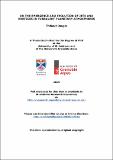Files in this item
On the emergence and evolution of jets and vortices in turbulent planetary atmospheres
Item metadata
| dc.contributor.advisor | Dritschel, David Gerard | |
| dc.contributor.advisor | Flór, Jan-Bert | |
| dc.contributor.author | Jougla, Thibault | |
| dc.coverage.spatial | xiv, 152 p. | en_US |
| dc.date.accessioned | 2019-06-18T15:24:26Z | |
| dc.date.available | 2019-06-18T15:24:26Z | |
| dc.date.issued | 2019-06-25 | |
| dc.identifier.uri | https://hdl.handle.net/10023/17924 | |
| dc.description.abstract | This thesis investigates the formation and evolution of jets and vortices in turbulent planetary atmospheres using a dual approach of high-resolution numerical simulations and novel laboratory experiments. A two-layer quasi-geostrophic beta-channel shallow water model is used for the numerical study. As in Panetta (1988), a vertical shear is implemented to represent a spatially-mean latitudinal temperature gradient, which is partially maintained by thermal relaxation. Baroclinic instabilities work to erode the temperature gradient, while thermal relaxation acts to restore it. As the basic state vertical shear is unstable, the thermal relaxation cannot lead to a full recovery, thus modifying subsequent instabilities and leading to rich nonlinear dynamical behaviour. First, we consider flow over a flat bottom, and model convective motions like those thought to occur on Jupiter by pairs of cyclones/anti-cyclones or ‘hetons’ as in Thomson (2016). We thereby obtain predominantly baroclinic jets, oscillating between quiescent phases, when jets are zonal and the energy is nearly stationary, and turbulent phases, when the flow loses its zonality, vortices pinch off from the meandering jets, and zonal energy components drop while eddy energy components increase. These turbulent phases typically last for a thermal relaxation period. The impacts of vertical shear (baroclinicity), thermal relaxation and heton forcing are comprehensively investigated by considering the energy transfers occurring between kinetic and potential energy, their barotropic and baroclinic parts as well as their zonal and eddy parts. This leads to a rethinking of the classic paradigm of energy transfer presented by Salmon (1982), as this paradigm is too simplistic to explain the results found. Then, we consider the effect of large-scale bottom topography, as a first approach to understanding the role of topography in jet and vortex formation. We use the same model as in the first study but include a linearly sloping topography which has the advantage of being characterised by a single parameter, the slope. We omit the heton forcing and instead perturb the flow with a small amplitude Rossby wave initially. The main effect of heton forcing is actually to act as a kind of damping: energy fluctuations are consistently less extreme than when no forcing is used. A linear stability analysis is carried out to motivate a series of nonlinear simulations investigating the effect of topography, in particular, differences from the flat bottom case previously examined. We find that destabilising topography makes the jets more dynamic. In the experimental part, a two-layer salt-stratified fluid is used in a rotating tank with a differentially rotating lid to generate the shear across the interface. We consider a baroclinically unstable front in the regime of amplitude vacillation, which is found to be characterised by the sequential emergence and disappearance of a large-scale vortex. Analysing two similar experiments at the limit of geostrophy, with different Rossby numbers Ro=0.4 and Ro=0.6, shows surprisingly different behaviours, with a baroclinic dipole for small, and a barotropic vortex for the large Rossby number. The small-scale wave activity is explored using different methods, and the results suggest small, spontaneously arising inertia-gravity waves preceding the emergence of the vortex which stirs the interface, thus having an impact on the mixing between the two layers. The recovery period of the amplitude vacillation, as well as the intensity of the vortex, increases with the Rossby number. For further research on fronts at two-layer immiscible interfaces, a very accurate novel optical method has been developed to detect the height and slope, based on the refractive laws of optics. The associated theoretical equations are solved numerically and validated in various idealised situations. | en_US |
| dc.language.iso | en | en_US |
| dc.publisher | University of St Andrews | |
| dc.subject.lcc | QB603.A85J7 | |
| dc.subject.lcsh | Planets--Atmospheres--Statistical methods | en |
| dc.subject.lcsh | Planets--Atmospheres--Mathematical models | en |
| dc.subject.lcsh | Vortex-motion | en |
| dc.title | On the emergence and evolution of jets and vortices in turbulent planetary atmospheres | en_US |
| dc.type | Thesis | en_US |
| dc.contributor.sponsor | University of St Andrews. School of Mathematics and Statistics | en_US |
| dc.contributor.sponsor | Observatoires des sciences de l'Univers de Grenoble | en_US |
| dc.type.qualificationlevel | Doctoral | en_US |
| dc.type.qualificationname | PhD Doctor of Philosophy | en_US |
| dc.publisher.institution | The University of St Andrews | en_US |
| dc.publisher.department | Université Grenoble Alpes | en_US |
| dc.identifier.doi | https://doi.org/10.17630/10023-17924 |
This item appears in the following Collection(s)
Items in the St Andrews Research Repository are protected by copyright, with all rights reserved, unless otherwise indicated.

